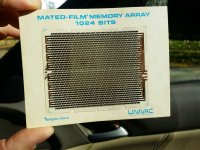- Delivery Options
- International Shipping
Very unique piece of computer history.
Bought it at a MN garage sale. Curious if it has any real value.
What I could find:https://www.computerhistory.org/collections/catalog/X93.82
Film Memory Development Work at Univac by Dick Petschauer.
This work started at Univac Research Dept under Dr. Sid Rubens in about 1954. I started in 1956 in the Memory Engineering Department. Specifically, I was assigned to do the circuit design in Dr Ruben’s group working for Dr. Art Pohm. Dr. Pohm was heading up a project to make an experimental memory. After completing this we got a contract from the Air Force Ballistics Missile Division. They wanted a non-destructive read out memory to replace the drum memories in on-board guidance computers.The Air Force was concerned about the reliability of the mechanical drum memories. The ferrite core memories used at that time had to be cleared every read cycle in order to determine if they stored a one or zero, after which the data was rewritten. For program storage there was a concern that transient errors could result in permanent changes in the memory. While the first thin film memories also needed rewriting each cycle, other ways to use them had the promise of providing non-destructive read out, or “NDRO”, operation.
The initial approach for NDRO used the technique of “reversible rotation“. A magnetic read field is applied perpendicular to the normal direction of magnetization which produces a small positive or negative signal depending on whether a one or zero was stored. However, for a number of reasons, operation was sometimes unreliable and many readouts and could cause partial demagnetization and loss of output signal. In the middle of the Air Force contract, we changed directions and adopted the “Bicore” approach, which used a two layered film with a “strong” layer and a “weak” layer. Writing was accomplished by switching the strong layer and its external magnetic field would force the weak film to a state that would close the flux path. Reading was done by clearing the weak layer with a smaller current and sensing whether it switched. The read current did not change the state of the strong layer. After reading, the strong layer would restore the weak layer.
This approach proved highly successful. The first test memory of 288 bits was built and described in a detailed internal paper written on July 29, 1960. This was followed by the construction of a larger 1024 by 36 bit and this was reported at the 1961 Western Joint Computer Conference in Los Angeles. All previous film memories were much smaller and were in a single plane. This memory was in a 16-plane stack, an industry first.
Improvements came rapidly. In May of 1962 Univac reported on a 166,000 bit Bicore memory. This was the basis for the Univac ADD airborne computer. It used both an NDRO film memory and a fast smaller DRO film memory in a very small 1.1 cubic foot computer, including power supplies. This was before the advent of the integrated circuits and used separate transistors, diodes, resistors and capacitors for all the circuits. The components were stacked a 3D “cordwood” style in small welded packages.

